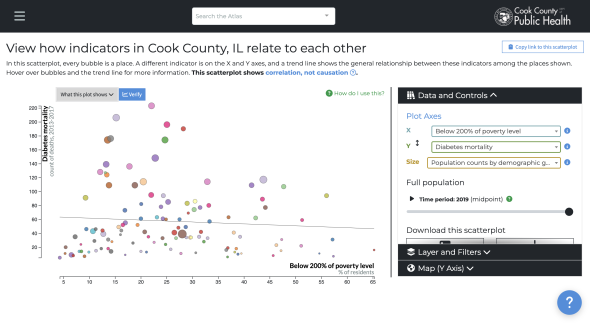School of Public Health data center leads new health database for Cook County
A new community-level public health data portal is now available for Cook County.
The Cook County Health Atlas is a searchable database that residents, community organizations, researchers and public health stakeholders can use to easily access, analyze and download neighborhood-level health data from 26 cities and 176 ZIP codes located in suburban Cook County. In the portal, users can look at more than 100 indicators of health and see them visualized in maps, charts, graphs and tables for free.
The atlas is a collaborative, multi-agency project facilitated by the University of Illinois Chicago, the Cook County Department of Public Health and Metopio, supported by funding from The Chicago Community Trust. The PHAME Center at the UIC School of Public Health oversees the database, which runs on a Metopio-powered interface.

Information from the atlas can be used to identify health concerns across the 126 municipalities represented and to identify and provide tools for exploring and communicating environmental, neighborhood and other social determinants of health.
While Chicago has had its own database for more than 10 years, nothing like this has been available to provide hyperlocal data about or to residents of Cook County.
“More and more, we are learning how important our environments and experiences are to our health outcomes. As we strive to improve public health throughout Illinois and the country, we must start with a recognition that these factors not only differ from one region to another, but sometimes block by block, and that we need to invest in tools to understand these hyperlocal differences,” said Dr. Wayne Giles, dean of UIC School of Public Health. “This includes bridging the gap we have in available data from urban areas, where there tends to be more health systems, policymakers and academics, for example, and suburban and rural areas.”
“The department exists solely to protect the health and ensure the conditions for optimal wellness for the residents in suburban Cook County,” said Dr. LaMar Hasbrouck, CCDPH chief operating officer. “The Health Atlas is a vital tool for assessing and prioritizing the conditions and drivers of health for the communities we serve. This visualization platform will bolster our data-informed approaches to achieving equitable health outcomes while allowing us to monitor the impact of our programs and services over time.”
The platform includes capabilities for community engagement and advanced analytics and data visualizations, and interoperability with the Chicago Health Atlas, which was established more than 10 years ago but relaunched in 2021 under similar administration from UIC and Metopio, a data, analytics and visualization software developer.
“Data shouldn’t be stuck in siloes or hard to access,” said Will Snyder, CEO and co-founder of Metopio. “Communities deserve easy access to data. They also deserve to be able to leverage data to understand populations and places regardless of their data science background. Empowering Cook County residents with the Health Atlas increases collaboration and creates opportunities to establish meaningful policy, partnerships and programs for positive impact.”
Many indicators are already available on the atlas, but additional indicators will be rolled out in phases over the next year.
The indicators already in the atlas include currently available data on community health status assessment, social vulnerability index, communicable disease prevalence and opioid mortality.
Phases two and three will include the addition of other currently available data. Phase two will include 2018-2020 mortality and natality rates and self-reported health information from high school students via the 2020 Youth Risk Behavioral Surveillance System. Phase three will include summaries of 2018-2020 hospital inpatient and outpatient data.
Phase four — planned for spring of 2023 — will include results from upcoming surveys, like the 2022 Cook County Health Survey, which will be administered in summer 2022, and the 2022 Youth Risk Behavioral Surveillance System, which will be administered in fall 2022.
Categories
Topics
